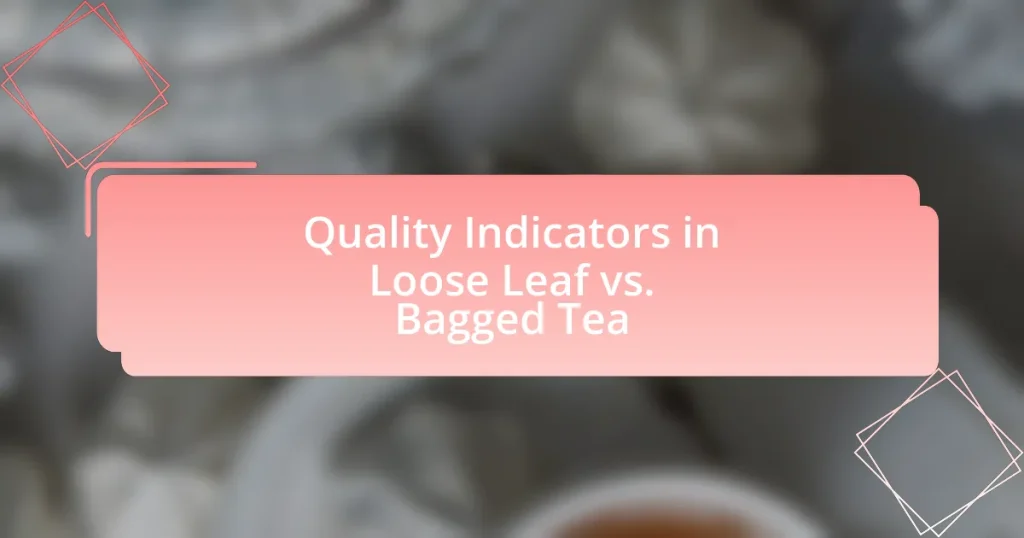The article focuses on quality indicators in loose leaf versus bagged tea, highlighting the differences in leaf size, shape, aroma, and overall freshness. It explains how loose leaf tea typically consists of whole leaves that preserve essential oils and flavors, resulting in a richer taste, while bagged tea often contains smaller particles that may lead to a quicker but less nuanced brew. Key characteristics defining quality in both types of tea are discussed, including the importance of sourcing, processing methods, and packaging. Additionally, the article emphasizes how these quality indicators impact flavor, aroma, and health benefits, providing consumers with practical tips for assessing and selecting high-quality tea.

What are Quality Indicators in Loose Leaf vs. Bagged Tea?
Quality indicators in loose leaf tea include leaf size, shape, and aroma, while bagged tea quality is often assessed by the presence of dust or fannings and packaging integrity. Loose leaf tea typically features whole leaves that provide a richer flavor and aroma, indicating higher quality, whereas bagged tea may contain smaller particles that can lead to a quicker, less nuanced brew. Research shows that whole leaves retain essential oils and flavors better than broken leaves, which are common in bagged varieties, thus affecting the overall taste experience.
How do quality indicators differ between loose leaf and bagged tea?
Quality indicators differ significantly between loose leaf and bagged tea, primarily in terms of leaf quality, flavor complexity, and freshness. Loose leaf tea typically consists of whole or larger broken leaves, which retain essential oils and flavors, resulting in a richer and more nuanced taste profile. In contrast, bagged tea often contains smaller, broken leaves or fannings, which can lead to a quicker infusion but may sacrifice depth of flavor and aroma. Additionally, loose leaf tea is generally fresher, as it is less processed and often packaged in a way that preserves its quality, while bagged tea may have a longer shelf life but can lose flavor over time due to exposure to air and light.
What specific characteristics define quality in loose leaf tea?
Quality in loose leaf tea is defined by several specific characteristics, including leaf size, aroma, color, and freshness. High-quality loose leaf tea typically features whole, unbroken leaves that indicate careful processing and handling. The aroma should be rich and fragrant, reflecting the tea’s origin and processing methods. Color is also a key indicator; vibrant, consistent hues suggest freshness and proper storage. Additionally, the tea should have a recent harvest date, as freshness significantly impacts flavor and overall quality. These characteristics are essential for distinguishing premium loose leaf tea from lower-quality options.
What specific characteristics define quality in bagged tea?
Quality in bagged tea is defined by several specific characteristics, including the type of tea leaves used, the freshness of the leaves, the packaging, and the flavor profile. High-quality bagged tea typically contains whole or larger leaf pieces rather than dust or fannings, which can lead to a more robust flavor. Freshness is crucial, as tea loses its flavor over time; thus, quality bagged tea is often sealed in airtight packaging to preserve its aroma and taste. Additionally, the flavor profile should be well-balanced and consistent, reflecting the specific type of tea, whether it be black, green, or herbal. These characteristics are supported by industry standards that emphasize the importance of leaf quality, freshness, and flavor consistency in determining the overall quality of tea products.
Why are quality indicators important for tea consumers?
Quality indicators are important for tea consumers because they help assess the freshness, flavor, and overall quality of the tea. These indicators, such as leaf appearance, aroma, and brewing characteristics, provide consumers with essential information to make informed purchasing decisions. For instance, high-quality loose leaf tea typically exhibits whole, unbroken leaves, which indicates better flavor extraction compared to bagged tea, often made from lower-grade dust or fannings. Studies have shown that consumers who understand these quality indicators are more likely to select teas that meet their taste preferences and health standards, ultimately enhancing their tea-drinking experience.
How do quality indicators influence the taste and aroma of tea?
Quality indicators significantly influence the taste and aroma of tea by determining the freshness, processing methods, and overall quality of the leaves. Freshness affects the volatile compounds responsible for aroma, while proper processing enhances flavor profiles. For instance, high-quality loose leaf tea often retains more essential oils and aromatic compounds compared to lower-quality bagged tea, which may contain dust or fannings that lack the complexity of whole leaves. Studies have shown that the presence of specific compounds, such as catechins and amino acids, correlates with a richer taste and more fragrant aroma, underscoring the importance of quality indicators in tea selection.
What role do quality indicators play in health benefits associated with tea?
Quality indicators significantly influence the health benefits associated with tea by determining the chemical composition and bioactive compounds present in the tea. High-quality tea, characterized by factors such as leaf grade, processing methods, and freshness, tends to have higher concentrations of beneficial compounds like catechins and flavonoids, which are linked to various health benefits, including improved cardiovascular health and antioxidant effects. Research indicates that loose leaf tea often contains more of these beneficial compounds compared to bagged tea, primarily due to less processing and better preservation of the leaves’ integrity. For instance, a study published in the Journal of Food Science found that loose leaf green tea had higher levels of catechins than its bagged counterparts, reinforcing the importance of quality indicators in maximizing health benefits.

What factors affect the quality of loose leaf and bagged tea?
The quality of loose leaf and bagged tea is primarily affected by factors such as the type of tea leaves used, the processing methods, and the packaging. The type of tea leaves, including their origin and cultivar, significantly influences flavor and aroma; for instance, high-quality leaves from specific regions like Darjeeling or Assam are known for their distinct characteristics. Processing methods, including oxidation and drying techniques, also play a crucial role; for example, green tea undergoes minimal oxidation, preserving its fresh flavor, while black tea is fully oxidized, resulting in a stronger taste. Additionally, packaging impacts quality; loose leaf tea often retains freshness better than bagged tea, which may contain lower-quality dust or fannings. Studies indicate that loose leaf tea generally offers a richer flavor profile compared to bagged tea due to these factors.
How does the sourcing of tea leaves impact quality indicators?
The sourcing of tea leaves significantly impacts quality indicators such as flavor, aroma, and nutritional content. High-quality tea leaves are typically sourced from specific regions known for their unique terroir, which influences the chemical composition of the leaves. For instance, tea from the Darjeeling region in India is renowned for its distinct muscatel flavor due to the specific climatic and soil conditions. Additionally, the method of harvesting, such as hand-picking versus machine harvesting, affects the leaf integrity and overall quality; hand-picked leaves are often more selective, leading to superior flavor profiles. Studies have shown that tea sourced from high-altitude regions tends to have higher levels of antioxidants, which are crucial quality indicators. Therefore, the sourcing process directly correlates with the overall quality of the tea produced.
What are the differences in processing methods for loose leaf and bagged tea?
Loose leaf tea and bagged tea differ primarily in their processing methods, which affect their quality and flavor. Loose leaf tea is typically processed with minimal handling, allowing the leaves to remain whole or in larger pieces, which preserves essential oils and flavors. In contrast, bagged tea often consists of smaller, broken leaves or dust, which are processed to fit into tea bags, leading to a quicker infusion but often sacrificing flavor complexity and aroma. The processing of loose leaf tea usually involves careful withering, rolling, oxidation, and drying, while bagged tea may undergo more mechanical processing to create uniformity and convenience. This difference in processing directly impacts the overall quality, with loose leaf tea generally offering a richer taste and more nuanced flavor profile compared to bagged tea.
How does the packaging of tea affect its quality over time?
The packaging of tea significantly affects its quality over time by influencing factors such as exposure to light, air, moisture, and odor. Proper packaging, such as airtight containers or foil pouches, minimizes these exposures, thereby preserving the tea’s flavor, aroma, and freshness. For instance, studies have shown that tea stored in opaque, airtight packaging retains its essential oils and volatile compounds better than tea in transparent or loosely sealed containers, which can lead to oxidation and degradation. This degradation can result in a loss of flavor and nutritional value, demonstrating that effective packaging is crucial for maintaining tea quality throughout its shelf life.
What are the sensory attributes used to evaluate tea quality?
The sensory attributes used to evaluate tea quality include appearance, aroma, flavor, mouthfeel, and aftertaste. Appearance assesses the visual characteristics such as color and leaf integrity, which can indicate freshness and processing quality. Aroma evaluates the scent of the dry leaves and the brewed tea, providing insights into the tea’s origin and processing methods. Flavor encompasses the taste profile, including sweetness, bitterness, and astringency, which are critical for overall enjoyment. Mouthfeel refers to the texture and body of the tea in the mouth, influencing the drinking experience. Finally, aftertaste measures the lingering flavors post-consumption, which can reflect the tea’s complexity and quality. These attributes are essential for distinguishing high-quality teas from lower-grade options.
How do flavor profiles differ between loose leaf and bagged tea?
Loose leaf tea generally offers a more complex and nuanced flavor profile compared to bagged tea. This difference arises primarily from the quality of the tea leaves used; loose leaf tea typically consists of whole or larger pieces of leaves, which retain essential oils and flavors better than the smaller, broken leaves often found in bagged tea. Studies indicate that the surface area of the leaves in bagged tea can lead to a quicker but less flavorful infusion, as the smaller particles release their flavors rapidly but may lack depth. Additionally, loose leaf tea allows for better water circulation during brewing, enhancing the extraction of flavors and aromas.
What visual indicators can help assess the quality of tea?
Visual indicators that help assess the quality of tea include the appearance of the leaves, color, and the presence of tips or buds. High-quality loose leaf tea typically features whole, unbroken leaves that are vibrant in color, indicating freshness and proper processing. For example, green tea should have a bright green hue, while black tea should display a rich, dark color. Additionally, the presence of tips or buds, which are younger leaves, often signifies higher quality, as these parts contain more essential oils and flavor compounds. The overall uniformity and size of the leaves also reflect quality; consistent leaf size suggests careful hand-picking and processing.

How can consumers assess the quality of loose leaf and bagged tea?
Consumers can assess the quality of loose leaf and bagged tea by examining factors such as leaf size, aroma, and packaging. Loose leaf tea typically features larger, whole leaves, which indicate higher quality, while bagged tea often contains smaller, broken leaves or dust, suggesting lower quality. The aroma of the tea can also serve as an indicator; high-quality teas emit a strong, pleasant fragrance, while lower-quality teas may have a dull or stale smell. Additionally, the packaging plays a crucial role; quality teas are often packaged in airtight containers to preserve freshness, whereas lower-quality teas may be found in non-airtight, mass-produced bags. These indicators help consumers make informed choices about the tea they purchase.
What practical tips can help consumers choose high-quality tea?
To choose high-quality tea, consumers should prioritize loose leaf tea over bagged tea, as loose leaf typically contains whole leaves that offer better flavor and aroma. High-quality tea often features specific indicators such as the origin, which can be verified through reputable sources; for example, teas from regions like Darjeeling or Uji are known for their superior quality. Additionally, consumers should look for freshness, indicated by a harvest date on the packaging, as tea loses flavor over time. The appearance of the leaves is also crucial; high-quality tea leaves should be whole, unbroken, and vibrant in color. Lastly, consumers can assess the aroma of the dry leaves, as a strong, pleasant scent often correlates with higher quality.
How can consumers read tea labels effectively?
Consumers can read tea labels effectively by focusing on key information such as the type of tea, origin, ingredients, and brewing instructions. Understanding these elements helps consumers assess quality and flavor profiles. For instance, the type of tea indicates whether it is black, green, or herbal, while the origin can suggest specific taste characteristics associated with regions known for tea production, such as Darjeeling or Assam. Ingredients should be scrutinized for additives or flavorings, as pure teas typically offer a higher quality experience. Additionally, clear brewing instructions on the label can enhance the tea’s flavor when prepared correctly. This approach allows consumers to make informed choices based on quality indicators relevant to both loose leaf and bagged tea.
What should consumers look for in terms of freshness and storage?
Consumers should look for the packaging date and the aroma when assessing freshness and storage of tea. Fresh tea should have a recent packaging date, ideally within six months to a year of purchase, as tea loses flavor and potency over time. Additionally, consumers should check for a strong, pleasant aroma, which indicates that the tea is still fresh. Proper storage is crucial; tea should be kept in an airtight container, away from light, moisture, and strong odors to maintain its quality. Studies show that exposure to air and light can degrade tea quality significantly, leading to a loss of essential oils and flavors.
What are common misconceptions about tea quality?
Common misconceptions about tea quality include the belief that loose leaf tea is always superior to bagged tea and that higher price guarantees better quality. While loose leaf tea often offers a broader range of flavors and aromas due to less processing, some bagged teas use high-quality leaves and can be just as flavorful. Additionally, price does not always correlate with quality; many affordable teas can be excellent, while expensive options may not meet expectations. Research indicates that factors such as freshness, storage conditions, and brewing methods significantly influence tea quality, rather than just the form or price.
Why do some believe bagged tea is inferior to loose leaf tea?
Some believe bagged tea is inferior to loose leaf tea due to the quality of the tea leaves used. Bagged tea often contains smaller, broken leaves or dust, which can lead to a less flavorful and aromatic brew compared to whole, high-quality leaves found in loose leaf tea. Research indicates that loose leaf tea allows for better infusion and extraction of flavors, as the larger leaves have more surface area and can expand fully during brewing. This difference in leaf quality and size contributes to the perception that bagged tea lacks the richness and complexity of loose leaf varieties.
How can consumers overcome biases when selecting tea types?
Consumers can overcome biases when selecting tea types by educating themselves about the differences in quality indicators between loose leaf and bagged tea. Research indicates that loose leaf tea generally offers superior flavor and aroma due to its larger leaf size, which allows for better infusion and extraction of essential oils and flavors. In contrast, bagged tea often contains smaller, broken leaves or dust, which can lead to a less nuanced taste experience. By understanding these distinctions, consumers can make more informed choices based on quality rather than preconceived notions or marketing influences. Additionally, tasting various types of tea and seeking out reputable sources for information can further help consumers recognize their preferences and reduce bias in their selections.
What are the best practices for enjoying high-quality tea?
To enjoy high-quality tea, it is essential to use the right water temperature and steeping time for each type of tea. For example, green tea typically requires water at around 175°F (80°C) and should steep for 2-3 minutes, while black tea benefits from boiling water at 212°F (100°C) and a steeping time of 3-5 minutes. Using fresh, filtered water enhances the flavor, as impurities can alter the taste. Additionally, using the appropriate amount of tea leaves, generally 1 teaspoon per cup, ensures optimal flavor extraction. These practices are supported by tea experts who emphasize that proper brewing techniques significantly impact the overall tea experience.


